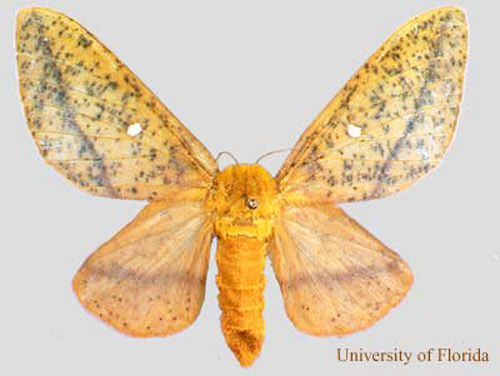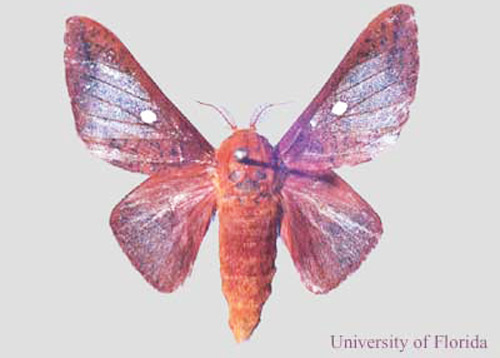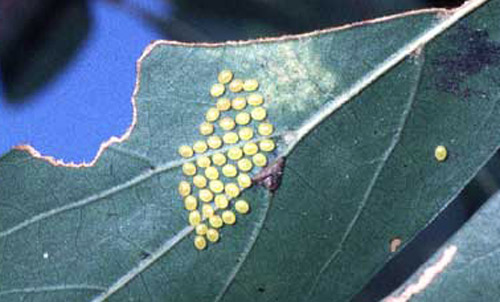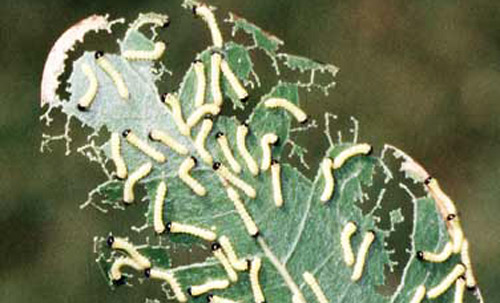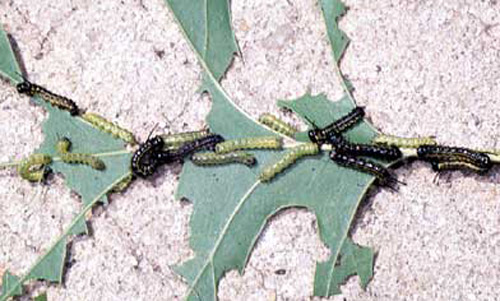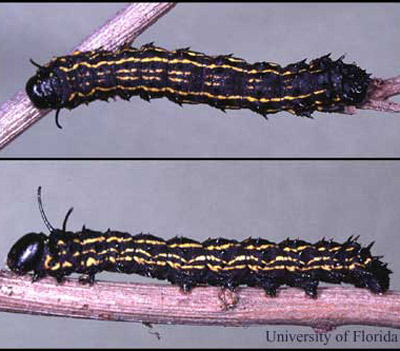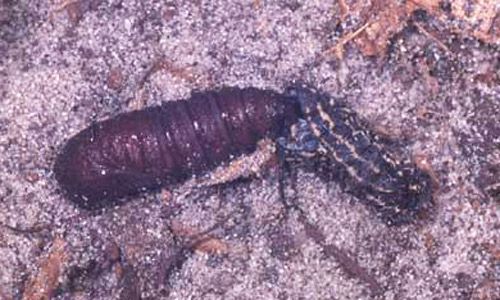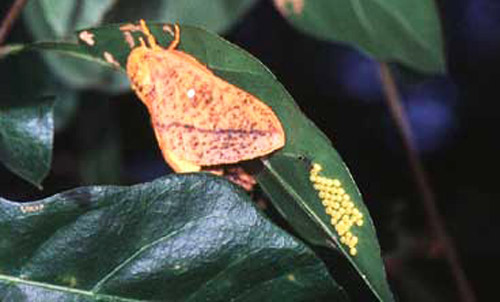common name: yellowstriped oakworm (suggested common name), Peigler's oakworm
scientific name: Anisota peigleri Riotte (Insecta: Lepidoptera: Saturniidae)
Introduction - Distribution - Description - Biology - Host Plants - Natural Enemies - Management - Selected References
Introduction (Back to Top)
The yellowstriped oakworm, Anisota peigleri, is an occasional pest on oak trees in the southeastern United States. In Florida, outbreak populations defoliated laurel, water and Shumard oaks in Gainesville from 1996 until 2001. Even when defoliation is not severe, the falling frass (droppings) and large numbers of caterpillars are a major concern for many homeowners. Frass commonly stains driveways, walkways, pool decks and other outdoor structures.
Distribution (Back to Top)
Anisota peigleri occurs in southeastern Kentucky, eastern Tennessee, western North Carolina, the Piedmont and coastal areas of South Carolina, northern Georgia, Alabama and north central Florida. Gainesville, Florida is the southern-most point at which it has been collected. The biologically similar orangestriped oakworm, Anisota senatoria (J. E. Smith), has a much larger range, occurring from Minnesota and Maine southward to Texas and Florida (Tuskes et al. 1996, Riotte & Peigler 1980, Serrano & Foltz 2003).
Description (Back to Top)
Adults: The adult female is reddish-orange in color and about 3/4 to 1 inch (18 to 25 mm) in length. The forewing has a small white spot, a dark line, and numerous dark speckles. The hind wings are somewhat paler and have an indistinct line. Females are distinguished from males by their larger size, threadlike antennae, and the characteristic shape and coloration of the wings. Males are smaller than females, the body ranging from 5/8 to 3/4 of an inch (15 - 20 mm) in length. The forewings are dark reddish brown with a small white spot and a larger whitish translucent patch. The hindwings are mostly reddish brown. Males have plumose (featherlike) antennae that they use to locate females by tracking the pheromones females release during their "calling."
Figure 1. Anisota peigleri Riotte moths are present during late August and early September. The female moth, illustrated here, is reddish-orange in color and 18 to 25 mm in length. The forewing has a small white spot, a dark line, and numerous dark speckles. The hind wings are somewhat paler and have an indistinct line. Females are distinguished from males by their larger size, threadlike antennae, and the characteristic shape and coloration of the wings. Photograph by David Serrano, University of Florida.
Figure 2. Anisota peigleri Riotte male moths are smaller than females, the body ranging from 15 to 20 mm in length. The forewings are dark reddish brown with a small white spot and a larger whitish translucent patch. The hindwings are mostly reddish brown. Males have plumose (featherlike) antennae that they use to locate females by tracking the pheromones females release during their "calling." Photograph by John L. Foltz, University of Florida.
Eggs: Eggs are yellow to orange-yellow in color (black when parasitized), spherical in shape, and about 1 mm in diameter.
Figure 3. Anisota peigleri Riotte eggs, shown here on the underside of an oak leaf, are yellow to orange-yellow in color (black when parasitized), spherical in shape, and about 1 mm in diameter. The eggs take from 1 to 1 1/2 weeks to hatch. Photograph by John L. Foltz, University of Florida.
Larvae: The first stage caterpillars are yellow with a black head and two prominent horns arising from the second thoracic segment. The second stage caterpillars retain the yellow to yellow-green color and are slightly larger. During the third and fourth stages the caterpillars change from the yellow to yellow-green color to a black color. Eventually, larvae become black-bodied with yellow stripes running along their sides. Fully-grown larvae may be 2 inches (50 mm) long. All have the black coloration with yellow stripes, prominent black horns arising from the second thoracic segment, and a row of small spines running along the body behind each of the horns.
Figure 4. Anisota peigleri Riotte caterpillars from an egg mass stay together during the early stages. The small caterpillars, shown here on an oak leaf, consume only the soft portions of the leaf, leaving behind the leaf skeleton. Clusters of caterpillars can be easily located by looking in the vicinity of skeletonized leaves. Photograph by John L. Foltz, University of Florida.
Figure 5. During the third and fourth stages, shown here, Anisota peigleri Riotte caterpillars change from the yellow to a black color. Eventually, larvae become black-bodied with yellow stripes running down their sides. Photograph by John L. Foltz, University of Florida.
Figure 6. In late October, Anisota peigleri Riotte caterpillars are fully grown and may be 50 mm long. All have the black coloration with yellow stripes. There are prominent black horns arising from the second thoracic segment and a row of small spines along the body behind each horn. Photograph by Paul M. Choate, University of Florida.
Pupae: Pupae, like adults, vary in size according to sex. Male pupae range from 3/4 to 1 inch (18 to 25 mm) and female pupae range from 1 to 1 1/4 inch (25 to 30 mm) in length.
Figure 7. The pupa and cast larval skin of Anisota peigleri Riotte, the yellowstriped oakworm. Pupae, like adults, vary in size according to sex. Male pupae range from 15 to 20 mm and female pupae range from 18 to 25 mm in length. The pupae reside in the soil about 50 to 80 mm deep, "overwintering" for about ten months. Moths emerge the next year to begin the cycle again. Photograph by John L. Foltz, University of Florida.
Biology (Back to Top)
The yellowstriped oakworm has only one generation per year throughout its range. Here is the life cycle we have observed in northern Florida where it is generally about one month later than in northern Georgia and the western areas of the Carolinas. Moths begin appearing in mid-August and are present into early September. Moths may be seen resting on shrubs, tree trunks, and the walls of buildings. Females, after mating, lay about 150 eggs (range 15 to 380). Egg clusters are generally located on the underside of oak leaves at the ends of the lowest branches. Spent females are sometimes found beside their eggs.
Figure 8. Anisota peigleri Riotte females lay their eggs on the underside of oak leaves in clusters containing from 10 to 374 eggs, the average being about 150 eggs. Eggs are generally located at the ends of the lower branches. Sometimes a female can be found resting on the base of the leaf after the eggs are laid. Photograph by John L. Foltz, University of Florida.
Hatch occurs in 1 to 1 1/2 weeks and then the small caterpillars move to an adjacent leaf to begin feeding as a group. These small larvae consume only the soft portions of the leaf, leaving behind the leaf skeleton. At this stage the caterpillars are most easily located by looking in the vicinity of skeletonized leaves. After several days of feeding and growing, the 1st stage caterpillars shed their head capsule and skin and become second stage larvae. Caterpillars continue to feed and stay in groups. Larger caterpillars consume entire leaves leaving branches with nothing but bare twigs. After five to six weeks, the mature caterpillars cease feeding and disperse down from trees to pupate. This is the time, about mid-October in Florida, when most people notice and are likely to be bothered by the oakworms. Oakworms pupate about 2 to 3 inches deep in the soil, overwintering in this stage for nearly ten months. Moths emerge the next year to begin the cycle again.
Host Plants (Back to Top)
Anisota peigleri feeds on various oaks in the red oak-black oak group. In Florida this oakworm feeds primarily on Shumard oak (Quercus shumardii) and water oak (Quercus nigra). Other common hosts are laurel oak (Quercus laurifolia) and southern red oak (Quercus falcata). Live oak (Quercus virginiensis) is a white oak and does not support larval development.
Natural Enemies (Back to Top)
Oakworm populations are subject to the typical variety of parasites and predators that affect leaf- feeding insects. Primary parasitoids of Anisota peigleri are the Hymenopterans Hyposoter fugitivus (Say), Anastatus reduvii (Howard), and Aprostocetus sp. and the Dipterans Winthemia datanae (Townsend), Lespesia anisotae (Webber), and Gnadochaeta sp. Secondary parasitoids, all Hymenoptera, are Isdromas lycaenae (Howard), Gelis tenellus (Say), Perilampus hyalinus (Say), Ceratosmicra meteori Burks, and Brachymeria ovata (Say). Invertebrate predators include jumping spiders and vespid wasps. Vertebrate predators include birds that prey on caterpillars in the trees and moles, mice, and shrews that prey upon caterpillars and pupae on the ground. Also, various pathogens likely infect pupae in the soil.
Management (Back to Top)
Oakworm populations occasionally reach levels that completely defoliate host trees. Most oaks can tolerate one such defoliation with little impact on their health. Repeated defoliations, however, will weaken the trees and lead to infestation by secondary insects and pathogens.
Here are some steps for promoting tree vigor and reducing yellowstriped oakworm populations:
- Provide appropriate water and nutrients to the tree throughout the growing season.
- Watch for and remove eggs and young colonies from the lower branches.
- If large numbers of caterpillars are too high for removal, contact a pest control operator for application of an appropriate insecticide.
Insect Management Guide for landscape plants
Selected References (Back to Top)
- Ferguson DC. 1971. Bombycoidea, Saturniidae (part), In Dominick RB et al., The moths of America north of Mexico. E.W. Classey, London.
- Peigler RS. 1994. Catalog of parasitoids of Saturniidae of the world. Journal of Research on the Lepidoptera 33: 1-121.
- Riotte, JCE. 1975. Ein neue Art der amerikanischen Gattung Anisota (Lep., Saturniidae). Entomologische Zeitschrift 85: 105-110.
- Riotte, JCE., Peigler RS. 1981. A revision of the American genus Anisota (Saturniidae). Journal of Research on the Lepidoptera 19: 101-180.
- Serrano D, Foltz JL. 2003. Natural history of Anisota peigleri (Lepidoptera: Saturniidae) in Gainesville, Florida. Florida Entomologist 86: 217-218.
- Tuskes PM, Tuttle JP, Collins MM. 1996. The wild silk moths of North America: A natural history of the Saturniidae of the United States and Canada. Cornell University Press.
